Wildlife gardening - Butterflies and Moths
Making a garden to attract butterflies and moths

Butterflies are amongst the most beautiful of our wild creatures and almost never fail to bring a smile to your face (unless, of course, it's a cabbage white butterfly laying eggs on your cabbages). Their bright colours and delicate wings are a joy to be behold and, if they stay still for long enough, you can clearly see their furry bodies and the patterns on their wings.
Moths are not as easy to spot as most of them fly at night, but there are a few that fly in the day time and some are both interesting and lovely to look at.
Both butterflies and moths help to pollinate flowers so that the plants will have fruit and seed, so they are good for your wildlife garden.
Unfortunately, because of the reduction in the plants that feed them, there are not as many butterflies and moths about as there used to be. If you plant your garden to attract them, you can help to safeguard their future.
What do they feed on?
Butterflies and moths live on the nectar from flowers and in autumn you can also see them drinking the juice from fallen fruit. A strange thing about butterflies is that they have taste buds in their feet, so that they can sample a flower by walking on it, without needing to stick their 'tongues' out first.
The butterfly and moth tongues are called a 'proboscis'. The proboscis is surprisingly long and when it isn't sticking out, it is curled up into a tight spiral. When they want to drink nectar they uncurl it and dip it into the flower.
In the picture is a small tortoiseshell with its proboscis partly uncurled. We found it in a cool room in our house, where it had been hibernating. It had woken up so we gave it some sugar water before finding it somewhere else to sleep.
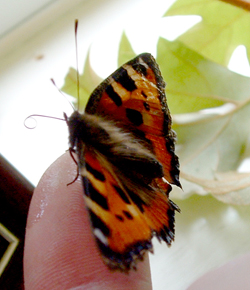
Small tortoiseshell with unfurled proboscis
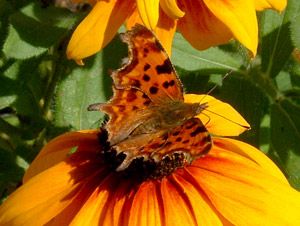
Comma butterfly on a rudbeckia flower - this is my favourite butterfly.
What butterfly where?
You'll find that you get different types of butterfly in your garden depending on where you live and what sort of plants are growing nearby.
In most urban gardens with plenty of flowers you'll see the 'usual suspects': cabbage whites, peacocks, red admirals, commas and small tortoiseshells.
The comma butterfly gets its name from a white dot mark on the underside of each of its wings.
Woods and fields
If you live near open fields, you may see a speckled wood or a gatekeeper butterfly.
Many butterflies of open fields have a habit of moving very fast (so it isn't as easy for them to be caught and eaten by birds) and it can be difficult to get a good look at them, because every time you get to where they've stopped, they fly off again - but do persevere as they can be very pretty to look at close up.
The gatekeeper butterfly in the picture is feeding on the rich nectar in clover flowers growing in a field. Even though one of its wings is a bit ragged, it flew very fast in a zig zag pattern that was difficult to keep track of and it took quite a while to get a photograph.
Sometimes, it can be easier to take a picture and then look at it at home, rather than trying to examine a butterfly close up in real life.
Many woodland butterflies don't move as quickly as field butterflies and are easier to observe. The speckled wood butterfly in the picture has a slower, less erratic flight and also has colours that help it to blend into the dappled shade of its woodland home. I got quite close to this one and it didn't fly away.
If you live near grassy chalk hillsides, you may be lucky enough to see one of the UK's beautiful blue butterflies.
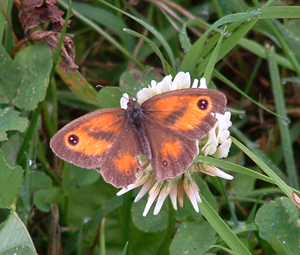
Gatekeeper butterfly feeding on clover
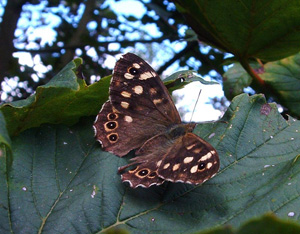
Speckled wood butterfly
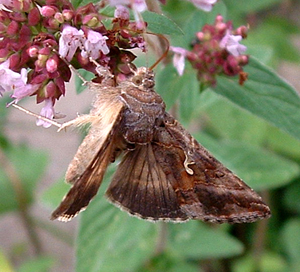
Silver-Y moth
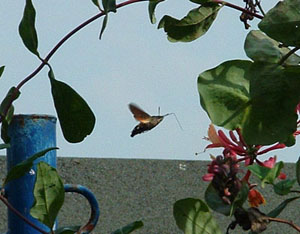
Humming-bird hawk-moth
Moths
There are probably as many moths about at night as there are butterflies during the day. Many of them are a lot duller in their colouring than butterflies but they are still interesting to look at and some of them are very pretty.
While most moths fly at night, not all of them do. The moth on the right is a Silver-Y moth - you can just make out the squiggly, creamy 'y' on its right wing. Some breed in the southern UK but many migrate here in summer and can arrive in large numbers.
In 2006 there was a huge migration of Silver-Y moths to the UK, and we had hundreds of them in our garden for several weeks. They spent most of their time around oregano and lavender flowers.
Another day-time flyer is the hummingbird hawk moth. Like the Silver-Y, it is also a migrant and the ones we see in the UK have often flown over from France.
The humming-bird hawk-moth is so called because it looks and behaves much like a hummingbird. Its wings flap so fast that they are just a blur and it moves very quickly from flower to the next, always hovering over the flowers it feeds from.
The humming-bird hawk-moth in the picture was seen in September 2005, which was a good year for them. You can just see its proboscis sticking out as it moves in to feed on a honeysuckle flower.
Burnet moths also fly in the day time and are worth looking out for to see their striking colours. Their heads, bodies and legs are black, while their wings are a dark charcoal colour with six bright red spots on each wing.
They live in areas with plenty of wild flowers for the adults and caterpillars to feed on. The moths in the picture are feeding on knapweed flowers.
These moths favour grass land, with many wild flowers, as their home. They don't 'do' much, as far as humans are concerned, but they are an important part of the food chain and provide part of the diet of many birds.
Many field moths and butterflies are in danger because of the loss of grassland due to farming and building development.
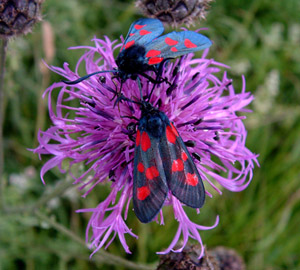
Burnet moths on knapweed
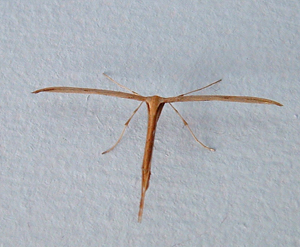
Plume moth
The plume moth is another one to look out for. This is my favourite kind of moth, because I find it so strange and beautiful.
When this type of moth is resting, it's wings appear very narrow, but when they take flight the wings open up into five or more segments, with each segment overlapping the other.
Plume moths can be found in many gardens in summer as well as in grass land and on waste ground. They will sometimes be found indoors on summer and autumn evenings, where they will show up as a small 'T' shape on a wall, ceiling or window.
Somewhere to hibernate
As well as needing food and shelter in summer, butterflies and moths also need somewhere to hibernate. This should be somewhere sheltered and unheated so that they can sleep through the winter till spring without being disturbed.
Some will find gaps in walls or in piles of wood. Others may get into barns, open sheds, outbuildings or greenhouses where they will tuck themselves into gaps and go to sleep.
The butterfly in the picture was in our house, sleeping amongst the leaves of a house plant. This wasn't really a good place for it because, although it was in a room which isn't used a lot, it does sometimes get heated which will wake the butterfly up.
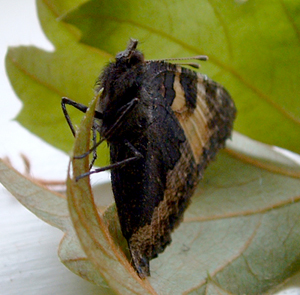
Hibernating butterfly
If a butterfly wakes up from hibernation, then it will need to eat something if it is to survive till spring. If you find a sleeping butterfly in your house, and it wakes up, give it some sugar water and then put it in an unheated, sheltered place so it can continue to hibernate.
If you do need to move a butterfly, try not to touch its wings if you can avoid it, as they are very delicate and are easily damaged.
What to grow for butterflies and moths
Apart from growing the right plants, butterflies need a sheltered and sunny garden so that they can bask in the sun's warmth without being blown about. If your garden has this, then you can also grow many plants that will feed them and give them somewhere to roost at night.
The important thing is that the plants you grow are rich in nectar as this is the main part of the butterfly and moth diet. The best known butterfly plant is known as the butterfly bush, Buddleja davidii, well known for it's arching sprays of purple or white flowers.
If this is the only plant you grow, you can be almost guaranteed to have butterflies visiting at some point over the summer. It is very undemanding and easy to grow and will give scent and colour all summer long.
Here are some other plants to choose from:
Red valerian, Centranthus ruber, is a cottage garden type plant with sprays of clustered, tiny pink flowers. It is easy to grow and does well in dry soil.
All open, daisy type flowers - for example, asters (Aster amellus ‘Blue King’), heleniums (Helenium autumnale) or rudbeckia (Rudbeckia hirta) - are popular with butterflies as they are nectar rich and it is easy for the butterflies to get to the food.
Lavender (Lavandula stoechas subsp. pedunculata) is another favourite, with its tall stems topped with clustered purple, pink or white flowers. You'll also enjoy their scent in summer if you brush past them.
All types of scabious are popular with butterflies, as well as humans.
Primulas (Primula vulgaris) are another one to plant - they will almost look after themselves and will seed themselves about the garden. They are very good for butterflies that have woken up early before a lot of other flowers are open, because they flower in early spring.
Chives - you can eat the leaves and the butterflies can have the flowers.
Toadflax (Linaria purpurea) is a lovely flower in pink or purple. It will flower all summer long until the first frosts. It is also much loved by bees.
Verbena bonariensis - this is a tall plant that comes up every year. It has long thin stems and flat heads of small purple flowers. The flowers are only scented after dark so it's good for moths as well as butterflies.
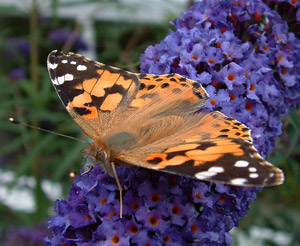
Painted lady on Buddleja
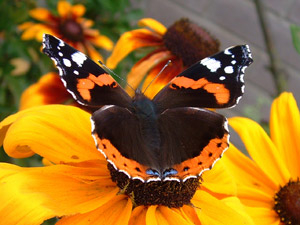
Red admiral on a rudbeckia flower
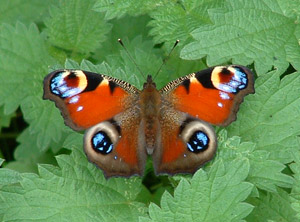
Peacock butterfly on nettles
Sedum - these plants also come up every year. They are very hardy and easy to grow, with large flat heads of tiny pink flowers. They will attract many insects apart from butterflies.
Finally, if you have space, leave a patch of nettles as many butterflies like to bask on the leaves on summer mornings.

© Copyright Miranda Hodgson 2007